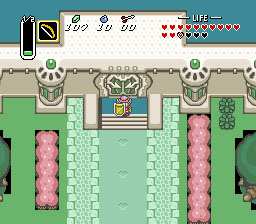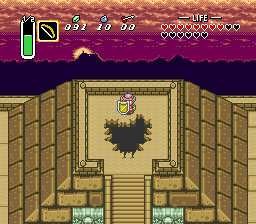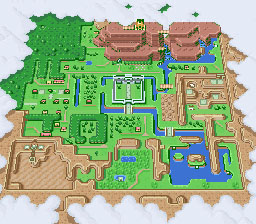 |
The Legend of Zelda - A Link to the
Past: Retroview |
 |
Double Entendre?
By: Andrew Long
| Review Breakdown |
| Battle System |
7 |
| Interface |
7 |
| Music/Sound |
9 |
| Originality |
6 |
| Plot |
4 |
| Localization |
9 |
| Replay Value |
8 |
| Visuals |
8 |
| Difficulty |
Medium |
| Time to Complete |
12-20 hours
|
|
| Overall |
 |
| Criteria
|
For almost as long as there has been Nintendo, there has also been the Legend of Zelda series. With each of Nintendo's systems, the games took on new form. Generally speaking, they shone, despite being released early in the development cycle of each respective system. The Legend of Zelda: Link to the Past is one such title. Released shortly after the Super Nintendo saw its advent, this title took the mechanics developed in the original and brought it to polished new heights. With some of the all-around best gameplay ever offered, The Legend of Zelda: A Link to the Past is a definite must-have title.
Unless you've been living under a rock, you probably know who Link is. Regardless of the incidentals found in the prologue or instruction manual, Link is a young boy who is unceremoniously given a sword and told to go save the world. True to form, in this game, Link's uncle, overcome by some nasty palace guards, hands over the sword and shield synonymous with the series and promptly vanishes, leaving Link to clear out the palace, save the princess, and figure out just why everything has been going down in sunny Hyrule. Soon enough, the answers start arising, and Link is forced to fight his way towards the evil behind the troubles.
Link comes equipped with not only the sword and shield given him by his uncle, but also a wide variety of alternate items, including the ubiquitous boomerang, bombs, and candle(or lantern, such as the case may be). There are also a number of other items which serve to aid the player, enabling anything from catching fairies for later use to creating blocks which can be pushed around. The game also has a magic system, which, though rudimentary, does add something in the way of challenge, since running out of MP makes a number of items useless, and magical spells quite naturally impossible to cast. In practice, then, while it's not particularly challenging to hack your way through any given group of them, Hyrule's denizens will gradually wear down most players until the fantastically irritating "you're in trouble!" beeping starts in.
Most Zelda titles tend to be geared towards a younger audience, and with a younger audience comes a system of menus both less complicated and more reliant on icons to get its job done. In this case, the icons are fairly unoffensive, and do not detract from the overall feel of the game; although the menus are slightly more complex than those found in the NES Zelda titles, the progression is smooth, never feeling particularly cluttered and managing to find a place for everything.

|
| The exotic ham gardens of Hyrule
|
|
With the jump to 16-bit technology, the sound effects make a bit of a leap too. Musically, there are relatively few tunes as compared with many other RPGs, but what the game lacks in quantity, it makes up for in quality. The immediately recognizable field theme has been touched up from its NES days, and sounds positively epic (at least by 1991 standards). Other tunes are well-suited to the areas they play in, such as the dungeon theme found in the Light World, and there really isn't anything cringe-inducing to speak of, with the possible exception of some grating instrumentation in one or two pieces. The sound effects have also made a bit of a leap; blips and bleeps have, for the most part, been replaced with more fitting effects, and particularly nice is the sound of Link's sword in its fully upgraded form. Basically, this game made the most of the sound technology at the time, and this helps to further enhance an already enjoyable title.
A Link to the Past manages to build upon the gameplay developed in earlier Legend of Zelda titles, and it retains enough elements from the previous titles to seem like a logical continuation of the series. Many items from the previous games return, and Link looks pretty much the same as he has always looked. Hyrule is Hyrule, and the general structure of gameplay- kill things, collect rupees, buy other things to make killing things easier- has been retained. That said, there are also a number of new features in the game that make it fresh enough that it's a whole new experience. New items have been added. New monsters are lurking in Hyrule. Heck, those 16-bit graphics were even new, at the time. The concept of two realms also appears for the first time in the series. Quests are generally longer, and more involved than those in previous titles. In the end, this combination is sufficient to make the game feel fresh.
On the downside, there isn't too much in the way of plot to go around. It's not that what's there isn't enough to keep the game plodding along; saving princesses and such is usually an entertaining pastime, as anyone from plumbers to knights in shining armour will attest to. Beyond that, however, not too much thought went into things. The game does have a decent enough backstory, but in practice, this doesn't have much impact on the game, and little is developed beyond what is found in the instruction manual. There are, of course, the odd subplots and intrigues, but these serve more as justification for the collection-based theme that drives the story, and plot generally takes a backseat to gameplay.
Despite being fairly light on story, A Link to the Past does have a fair amount of dialogue. All characters have something, sometimes several somethings, to say, and there is no shortage of people to be found in the Kakariko village, as well as the outlying areas. Generally speaking, the translation is done quite well. There are few errors to speak of, and the dialogue by and large makes sense.

|
| And to think he scoffed when they tried to sell him pyramid insurance... |
|
The gameplay in A Link to the Past is strong enough that playing the game over and over again is definitely a possibility. It's just great fun fighting through the various monsters of Hyrule, and it's certainly challenging enough that at no point does it become too easy. The fun factor is definitely high, and while there's no one thing that I can put my thumb on that makes the game inherently replayable, overall, the game is a lot of fun to play through, be it for the first time or the fifteenth.
Part of the endearing quality inherent in most Legend of Zelda titles is the accessibility to all ages the games have, and part and parcel with this comes a somewhat cartoon-like appearance. A Link to the Past is perhaps the best example of this artistic style, with both the characters and scenery possessing a definitely animated appeal. Most sprites in the game are very colorful, as are the spell effects. All in all, save obviously for various cave scenes, the game is very bright, and it creates a cheery atmosphere, even when things aren't going too well for Link. Some may not like this artistic style because of this childish nature, but it does suit the game well in terms of the style it strives to project.

|
| Hyrule: Where the sun is always shining |
|
As aforementioned, A Link to the Past is not terribly challenging, for the most part. Some puzzles require minimal effort to complete, but for the most part, the difficulty in completing them is largely restricted to finding the item required to do so. That said, finding some optional items can be deucedly difficult; to this day I'm still unable to find the accursed Magical Cape, and in turn the final chunk of heart which would give me a full complement. Overall, though, with this level of difficulty, the game shouldn't take too long to complete; twenty hours would represent a very slow player.
As time goes on, A Link to the Past becomes all the more significant a title. The game represents all of the features associated with the earlier games in the series, while at the same time introducing some stylistic and thematic elements that would factor prominently into the later titles. Its place in the Legend of Zelda series as a whole is thus very important, and more than that, it's also a fantastic game to play. Basically, you haven't really played Zelda until you've played this game, and play it you should.
|










